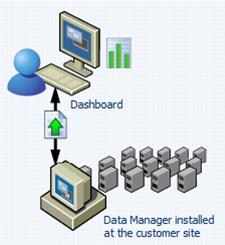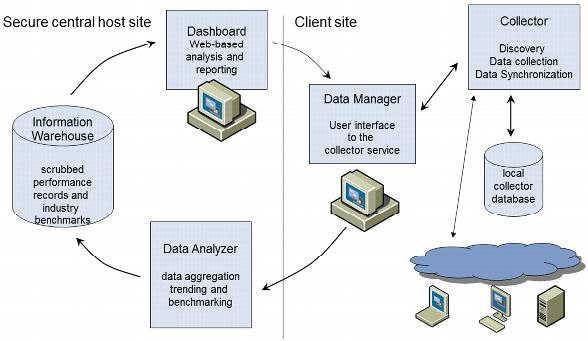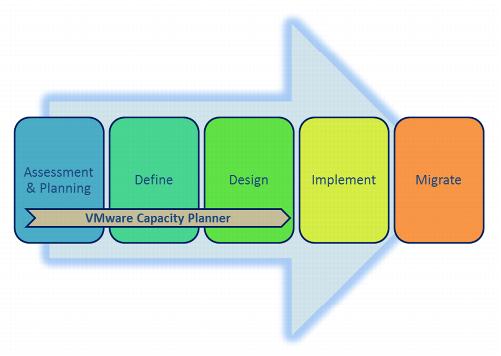3.1.1 What is Capacity Planner?
VMware Capacity Planner is an agentless and robust capacity planning tool that provides an integrated set of analysis, planning, and decision support functionality that accelerates the delivery of accurate and benchmarked infrastructure assessment services for vCloud workloads. It is an integrated platform for analysis, planning, and decision making that enables comprehensive capacity planning, virtualization, and consolidation assessments. These assessments help to virtualize and consolidate datacenter vCloud infrastructure, redeploy strategic IT assets, and optimize vCloud workload planned capacity utilization.
Capacity Planner enables not only current state analysis of the existing infrastructure landscape, but also “what-if analysis” of the preferred vCloud end state. It includes a rich set of components that deliver integrated capacity planning functionality including:

Data collection.

Data analysis.

Decision engine based
on industry benchmarks.

Monitoring capabilities.
The following are key components of Capacity Planner:

Data Collector
– The data collector is installed at the customer site and uses an agentless implementation to quickly discover systems. It collects detailed hardware and software inventory data
, as well as key performance metrics required for optimal capacity utilization analysis. The data collector can gather information from heterogeneous environments based on multiple platforms.

Data Manager
– The data manager manages the data collection process. It provides an organized view of the collected information and administrative control for the data collector including setting up the job schedules, and
starting, monitoring,
and stopping various data collection tasks. The data manager also manages the process by which the collected data is sent to the information warehouse.

Information Warehouse
– The information warehouse is a central hosted data warehouse where the data collected from the client environment is sent, scrubbed, aggregated,
and prepared for analysis. The information warehouse also includes valuable industry benchmark data that can be leveraged for benchmarking, scenario modeling,
and for setting utilization thresholds.
Data Analyzer
– The data analyzer serves as the core analytical engine that performs all the analysis required for intelligent capacity planning. It includes advanced algorithms that resolve capacity optimization challenges and support analysis capabilities such as aggregation, trending,
and benchmarking. Scenario modeling and the what-if analysis help to model and test various planning scenarios including virtualization, hardware procurement and server consolidation scenarios.

Capacity Planner Dashboard Portal
– The dashboard portal is a w
eb-based, hosted application portal that delivers capacity analysis and planning capabilities to users through a browser interface. Users can access a rich set of prebuilt analyses,
order and examine
data,
and create custom reports. Planning capabilities allow users to set objectives and constraints,
also model and test scenarios to arrive at informed capacity decisions. The monitoring capabilities of Capacity Planner dashboard enable proactive anomaly detection and alerts.
The following figure shows all of the Capacity Planner components.
Figure 2. Capacity Planner Components
3.1.1.1. When Should Capacity Planner be Used?
The vCloud delivery methodology is conducted in phases as shown in the following figure.
Figure 3. Capacity Planner Agile vCloud Delivery Methodology
Capacity Planner is typically used during the first three phases:
1. Assessment and planning.
2. Define.
3. Design.
3.1.1.2. Capacity Planner Alignment with Agile vCloud Delivery Methodology
VMware Capacity Planner is aligned with the phases of the Agile vCloud delivery methodology.
 Assess and
Assess and Plan:
 Assess the current state of an infrastructure’s workload capacity through comprehensive discovery and inventory of IT assets. Measure server loads and capacity utilization across various elements of the IT infrastructure by function,
Assess the current state of an infrastructure’s workload capacity through comprehensive discovery and inventory of IT assets. Measure server loads and capacity utilization across various elements of the IT infrastructure by function, location,
and environment. Plan for capacity optimization through detailed utilization analysis, benchmarking,
Plan for capacity optimization through detailed utilization analysis, benchmarking, trending,
and identification of capacity optimization alternatives. Identify resources and establish plan for vCloud-based virtualization, hardware purchase,
or redeployment. Define and
Define and Design
– Gather requirements and decide on the optimal solution by evaluating various alternatives through scenario modeling and “what-if” analyses. Determine which alternative best meets the predefined criteria. Monitor resource utilization through anomaly detection and alerts
based on benchmarked thresholds. Help generate design recommendations for
ongoing vCloud capacity optimization.
The effective use of Capacity Planner enables optimal design and construction of robust vApps that are published in the private or public catalogs in the vCloud Director, resulting in a scalable vCloud deployment.


